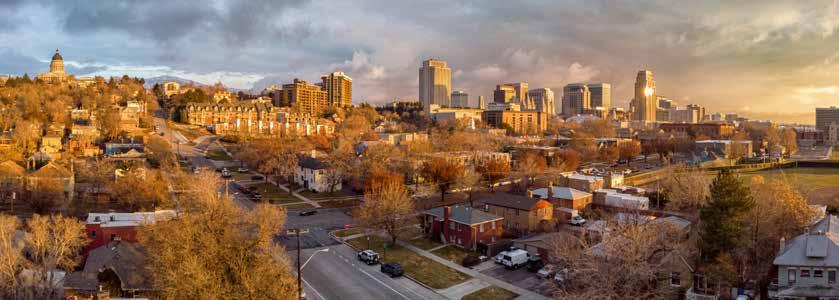
7 minute read
COMMERCIAL REAL ESTATE
Commercial Real Estate UTAH REAL ESTATE RISING UP TO FACE UNPRECEDENTED CHALLENGES
WRITTEN BY: CBRE
Advertisement
Commercial real estate is at the heart of the economy. No matter your circumstances, you are being impacted by the trends and health of commercial real estate; it touches where we work, play, shop, eat and live. For the past ten years, Utah’s economy has been expanding, bringing job, wage and population growth with it, but all that came to a halt in the second quarter of 2020 as the COVID-19 pandemic took hold of the world. Markets nationwide — including Utah — expected a degree of uncertainty in 2020 due to the length of the current business cycle and the presidential election, but nothing could prepare the world for what we’ve experienced. When you factor in the additional challenges of a major earthquake, hurricane-force winds and civil unrest, Utah has experienced its fair share of unique challenges recently. However, Utah’s strong foundation of business-friendly leadership, work ethic and its diverse economy and population have aided in keeping commercial real estate afloat — and even expanding in some cases — as the industry has risen up to meet a year of unprecedented challenges. GROWTH AND EVOLUTION
Despite recent road bumps, Utah’s commercial real estate industry experienced growth in 2020. At the time this piece was authored in November 2020, the industrial sector had 6.5 million square feet under construction and an extremely low vacancy rate of just 3.0%. Office construction remained at historical record levels with 3.5 million square feet under construction, though the vacancy rate was an elevated 14.7%. But regardless of property type, one common thread throughout the industry is that of COVID-19 acting as an accelerant to alreadyexistent transformations. For the past several years, there have been profound changes in the ways commercial real estate spaces have been marketed and utilized. Office users have been focused on creating more collaborative environments and reducing the amount of office space dedicated to individual workspaces, building more flexibility into their lease structures; retail investors have focused on omni-channel marketing to reach their customers across various platforms and create more immersive destinations; and industrial users have increased the efficiency of their buildings to incorporate advancements in technologies and logistics to accommodate the increasing volume of online sales. Though these trends had already taken hold, the need for strategic agility took center stage in 2020. Companies that had already begun to adapt to the changes within their industry have fared much better in the past year than those that were forced to start from scratch during the pandemic. When looking at the market as a whole, Utah has continued to earn national recognition for its sturdy economic growth, even during a global pandemic. The ability for many to work from home has created a changed mindset in the general populace and made Utah an even more attractive location for those seeking a market that offers year-round access to outdoor recreation.
OFFICE
Office space in Utah was arguably the market segment most affected by the pandemic, as remote work became the norm for the majority of office-using employees. In the previous cycle, the Salt Lake City-Provo office market experienced robust growth with steady construction taking place, but throughout 2020 office vacancy increased along with landlord concessions, as companies began to reevaluate their space needs. This has resulted in a steadily increasing inventory of sublease space available throughout the market, which had reached more than 2.1 million as of Q3 2020. The evaluation of a company’s needs for office space is nothing new; in fact, it’s a trend that began years ago and gave rise to many of the coworking and short-term lease options available in today’s market. Given the increase in remote work, prioritizing flexibility will continue to take precedence in the future. In September 2020, CBRE conducted a "Workforce Sentiment Survey" with a focus on remote work during the pandemic in which 32 companies in 18 countries participated. Three key takeaways from this survey were: 1) 90% of employees and employers feel remote work is productive, 2) 85% of employees prefer to work remotely at least two to three days per week in the future, and 3) 60% of respondents believe that office is here to stay and plan to return to the office for collaboration and community. The office segment will continue to evolve into a more agile environment to meet the growing desire and needs for ongoing flexibility, but office space is not going away. INDUSTRIAL
The phenomenal growth of Utah’s industrial sector has not skipped a beat during the past year’s challenges — record-breaking construction has persisted, while vacancy rates have decreased even further, ending Q3 2020 near record lows at 3.0%. The industrial segment’s growth has been augmented by the environment created by the pandemic, as more consumers have turned to online shopping to avoid doing so in-person. The convergence of the industrial and retail segments began long before the pandemic, but has grown even stronger, as large e-commerce

and logistics providers continue to dominate in the current economy. As such, the outlook remains very positive for the industrial segment, and demand and construction are projected to hold steady for the foreseeable future. RETAIL
Since the Great Recession of 2008, retail has been evolving toward experience- and servicebased models, as landlords have seen the need to attract customers to brick-and-mortar storefronts, but these business models were hit hard by pandemic-related restrictions. Many retailers are once again finding themselves forced to rethink things in an ongoing effort to keep their properties and products safe and accessible. However, retail has become increasingly resilient as it has faced the need to reinvent itself multiple times in recent decades. What we have seen in retail is a bifurcated environment where certain businesses are faring quite well, while others have faced far greater challenges. The already-begun focus on omni channel retail — the ability to reach customers across multiple platforms and locations — has added a level of security to those businesses who have implemented this business model. In addition, new big-box vacancies have been countered by new construction and positive user activity, leaving vacancy at a healthy 7.2% as of Q2 2020. This balance of resiliency has led to a retail market that continues to hold its ground. As commercial real estate markets in Utah grow and evolve, so do its sources of capital, and when it comes to financing investments, 2020 was a banner year. Despite the uncertainty caused by the pandemic, debt and equity levels remained elevated throughout 2020, as historically low interest rates equated to opportunities for cheap debt. (It’s important to remember that these totals consist of both refinances as well as loan originations.) Investor interest in Utah properties remained constant, though certain property types were in higher demand than others. Multifamily continues to be the darling of the Utah investment market, with industrial and office performing favorably as well. Despite short-term struggles, investors still view the Utah investment market as one with strong economic fundamentals and mid- to long-term positive growth potential. LOOKING AHEAD WITH OPTIMISM
A little over ten years ago, global markets collapsed, creating the steepest economic downturn since the Great Depression. Though many have been anticipating a similar market correction for years, the economic aftermath of COVID-19 still came as a massive shock. Previous to Q2 2020, Utah’s commercial real estate market was thriving, and thanks to the groundwork laid by many businesses during the past economic expansion, the industry is still relatively healthy. Real estate investors and users have seen the need to "right size" the amount of office space leased and have implemented omni-channels into their supply chains to offer customers multiple purchasing options. Likewise, logistics companies have aided the new retail environment by adjusting the size and technologies of their buildings. The COVID-19 pandemic accelerated these trends — and many others — forcing real estate users to become even more flexible and strategic in the way they develop and operate. Those companies which had been resistant to change prior to the pandemic have had a harder time playing catch-up in the midst of such a challenging environment, but companies that are adaptable will continue to succeed, further strengthening the local commercial real estate market. For further statistics and analysis on Utah’s commercial real estate market, visit cbre.com/ slc. *due to publishing timelines, all statistical figures in this article are either Q3 2020 data or initial year-end projections and may differ from published Q4 2020 figures

All Utahs should be able to afford a home in the community where he or she works.
Utah Housing Corporation can help.
Down Payment Assistance
If cash at closing is your challenge, a Utah Housing Down Payment Assistance Second Mortgage can help. When combined with our first mortgage, qualified borrowers can purchase a home with little or no cash investment.
Home Loans
Utah Housing Corporation, a Utah State independent government entity, has several mortgage loan programs to help you purchase a home with credit scores of 620 and higher.
Eligibility
First-time homebuyers and previous homeowners with low-to-moderate incomes for owner-occupied properties, such as single family and two-unit dwellings, condominiums, PUD’s, and manufactured homes.










